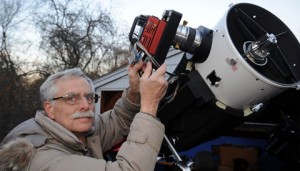Should I wear eyeglasses while observing?

If you are near-or farsighted, with no other eye problems, definitely take them off. You’ll have to tweak the focus, but you’ll see objects in the telescope just as clearly as if you had 20:20
vision. By taking off your glasses you’ll avoid the “tunnel vision” effect often caused when glasses keep your eyeball too far from the eyepiece.
If you have astigmatism, however, you aren’t so lucky. You should wear glasses for all low-power observing, but you can probably get away with taking them off when you are examining the Moon, planets, or anything else at high magnification.
Arizona optical designer Richard Buchroeder devised this handy rule. If the amount of “cylinder” (in diopters) in your eyeglass prescription is D, you can remove your eyeglasses whenever the telescope’s exit pupil (in millimeters) is 1/√ D or smaller. A larger exit pupil means your uncorrected eye will contribute more than 1/4 wave of aberration, and image quality will noticeably suffer. Let’s say your eye needs a cylinder correction of 0.7 diopter (which is not much). The maximum exit pupil is then 1/√0.7, or 1.2 mm. Since the diameter of the exit pupil equals the aperture divided by the magnification, you’ll be able to use a 4-inch (102-mm) telescope at 85× or higher without wearing
glasses.
— Gary Seronik
 0
0







Comments
You must be logged in to post a comment.